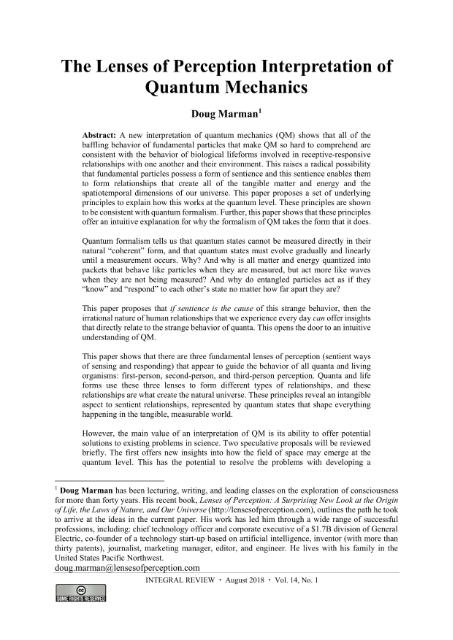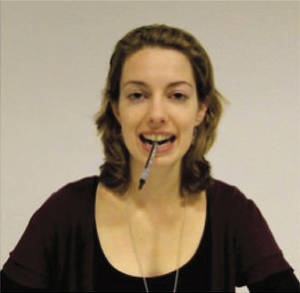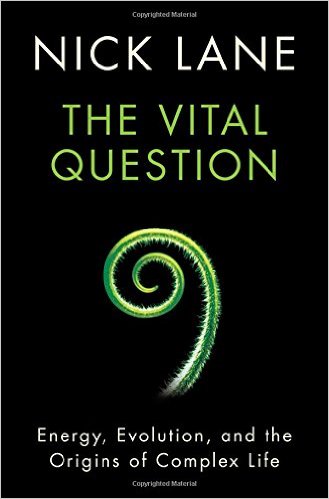By Doug Marman
Nick Lane recently published a new book, The Vital Question: Energy, Evolution, and the Origins of Complex Life. It isn’t an easy book to read, but it is packed with the latest research about the evolution of early life, and it offers a number of provocative new theories.

The Vital Question by Nick Lane.
Everything in Lane’s book fits perfectly with the theory of how life began that I presented in Lenses of Perception. However, Lenses fills in some important gaps in Lane’s story. That’s what I’ll be reviewing in this post.
Lane explains why we need to start looking at living organisms in a different way. The question we should be asking ourselves, he says, is not what is life, but how do creatures live? How do they extract energy from the world to keep them going? It’s an interesting perspective.
Lane then describes the process that all living things use to control energy. He even has a good story about where such a process probably began. But he can’t explain how living things gained the ability to intelligently control energy in the first place. This is where current science hits a wall. Fortunately, the Lenses of Perception theory shows a way to understand this missing key of life.
Lane’s book is filled with valuable insights. For example, out of date origin-of-life stories don’t work. The idea that lightning hitting the “primordial soup” (in the oceans) was able to create larger, more complex molecules, is a dead end. There is no way these molecules just arranged themselves into the right pattern and leaped the hurdle to life. Lane says the whole conjecture is misguided and should be forgotten.
The problem isn’t making complex molecules, he says. It is how to extract the energy needed to survive. Lightning can’t create the spark of life, because organisms need a continuous source of controllable energy to live. Lane believes the whole idea of the primordial soup is a big mistake that has led countless researchers in the wrong direction.
Lane then dives deep into describing how all life forms on Earth use energy:
“Essentially all living cells power themselves through the flow of protons… The energy we gain from burning food in respiration is used to pump protons across a membrane, forming a reservoir on one side of the membrane. The flow of protons back from this reservoir can be used to power work in the same way as a turbine in a hydroelectric dam… At the level of proteins, we now know how proton power works in detail. We also know that the use of proton gradients is universal across life on earth—proton power is as much an integral part of all life as the universal genetic code. Yet we know next to nothing about how or why this counterintuitive mechanism of energy harnessing first evolved.”[1]
In other words, even the simplest forms of life have a way of moving protons, one at a time, across a membrane, where they are stored like money in a bank. Later, they spend their proton loot to power everything they need to do, in order to survive. It’s an amazing discovery, but how exactly does the cell intelligently control this process? And how did the first life form learn this trick? Biologists don’t know.
That’s where the Lenses of Perception theory comes in. It proposes that the “all-for-one” bond is the secret of life we are looking for. This bond compels molecules of a cell to work in a coordinated way together for the cell’s survival. Outside forces can’t pull this off. The forces known to physics can’t make inorganic matter alive. Chemists and physicists haven’t found the right lens to see how this happens. But an understanding of relationships can explain it.
The process must start within the cell. The molecules must act in just the right way, to allow the cell to live. Why do they do this? According to Lenses of Perception, a special form of entanglement makes this possible.
The molecules in a cell are not only entangled with each other, forming a cohesive group, but they are also entangled with the cell itself. As a result, the molecules act as a team that is aligned to the cell.
This is admittedly a controversial theory, because most physicists believe that the unpredictable nature of quantum particles is, first of all, completely random, and second, it only happens at the subatomic level. Neither of these are true, however, since we see the same unpredictable behavior at the level of living cells, as well as at the level of complex organisms such as animals.
Lenses of Perception shows that the relationships between living creatures display all the same puzzles and paradoxes of quantum mechanics. This isn’t a coincidence. Fundamental particles are unpredictable because they, too, are conscious. This turns out to be a useful explanation because the spontaneous actions of quanta can’t be explained by outer forces.
If particles are conscious, then they should form relationships. This ends up being the true cause of attraction and repulsion between particles that creates the forces of physics. This might sound preposterous, but it’s completely consistent with quantum theory. (See Lenses of Perception for a detailed discussion.)
One type of relationship that forms naturally when beings come together is for them to work as a group. They form unified teams if they have good leaders. This bond, I believe, is the key to unlocking the secret of life. Once we realize the universal nature of what I call the “all-for-one bond,” we gain a new lens that shows us life in a completely different light.
For example, at the subatomic level, we see quarks coming together to form protons and neutrons. The units they form are so tightly bound together that they act as singular entities. They don’t spin like a group of quarks—they spin as one.
Protons and neutrons also bond together in the same way to form atoms. And this shows us one of the amazing results of this bond: It creates hierarchies. Not only do quarks combine to form protons, and protons combine to form atoms, but atoms also bind together to create stars, and stars form galaxies.
You might think that stars spin in galaxies only because of the force of gravity, but this is wrong. Scientists say that dark matter is needed to explain a strange problem: Why do the outer stars in galaxies spin as one? Gravity, alone, can’t explain this. The outer stars should spin slower, if only gravity is involved.
Unfortunately, physicists have no idea what dark matter is. And they don’t know why the outer sheath of the sun spins faster than it should, as well. Plus, a similar situation exists at the level of protons and atoms, called the “mass gap problem.” All of these problems are resolved, once we see the role of all-for-one bonds. (While I’m trying my best to make this understandable to newcomers, I can’t possibly cover all of the background in Lenses of Perception, so this is understandably a very quick summary.)
All-for-one bonds always create hierarchies because the group is held together by following a higher level leader. This is exactly why cells work together to allow complex organisms to live, and are even willing to sacrifice their lives for the sake of the creature. We see the same thing on a human level, when parents make sacrifices for their family, and when people come together to work for a company or a cause larger than themselves.
If this theory is right, then it paints a new picture of how cells first formed. In fact, the LoP theory is quite specific about how this must have happened. It had to start with a group that formed behind a leader who was one of their own. In other words, one molecule stepped forward to lead, but this role was temporary.
Any leader that steps forward from a group can be replaced. Actually, the members of the group can be replaced as well. This is exactly what we see in companies. They might get started with an entrepreneur, but other leaders take over as they expand, and employees come and go.
This first step is called a weak all-for-one bond, according to Lenses of Perception. The group isn’t held together as tightly as a cell, an atom, or an organism. In fact, weak all-for-one bonds can easily split into separate groups that go off in different directions. This is exactly what we see with companies. It also shows that reproduction probably existed before the first true cells emerged.
But weak all-for-one bonds have one big advantage over strong all-for-one bonds: They can survive indefinitely, as long as individuals continue stepping in to keep them going. That’s not true with organisms. When an animal dies, the cells that form its body all fall apart and decompose. This shows how closely their lives are entangled.
So, the first stage in the emergence of life is a loosely formed group that follows a temporary leader. A major evolutionary leap was needed to transform this group into a cell with a will of its own, creating a strong all-for-one bond. But I’m not going to discuss that stage in this post. I’ll address it in Part II.
Back to the pre-cellular stage. It probably survived for a long time, replacing leaders and members, before making the leap to becoming a unified conscious cell. In other words, it started as a community of molecules, and it must have taken a long time to evolve the ability to keep the group going. How did this happen? you might ask.

Hydrothermal vents deep under the ocean, near the Marianas Trench. Photo by the US National Oceanic and Atmospheric Administration.
Let’s turn back to Nick Lane. He tells an interesting story. Deep in the oceans on Earth are alkaline hydrothermal vents that offered exactly the right conditions for this process to begin. The vents are porous, with millions of tiny openings, making a perfect gathering place for molecules to settle and combine. The vents also supply a continuous flow of charged ions, while the rest of the ocean was much more acidic in those early days.
This allowed molecules to gather in the porous openings, creating something similar to membranes. And the vents supplied a natural source of protons, in the form of hydrogen ions, making a reservoir on one side. This created an electrical potential compared to the acidic ocean on the other side of the membrane. Therefore, there was a steady flow of energy that lasted for hundreds of millions of years. This is how long it took for a community of molecules to develop the ability to survive as a group.
This picture that Lane paints is consistent with the origin of life story in Lenses of Perception. It does seem like a realistic place for life to emerge. However, I don’t see how molecules could have evolved the ability to act as a group for its own self-preservation without the all-for-one bond. It can’t be created by external forces. That’s impossible. How could outside forces give creatures a will of their own? It must, by definition, come from within. This means that molecules must have first learned to keep the group going. Then the leap to cellular life was possible.
If consciousness exists first, and all particles possess it, then groups should naturally form, and the way they relate to each other should develop. In other words, they will gradually begin working as groups. That’s where molecules come from. But their abilities are very limited.
However, when molecules work together, they have far more flexibility (degrees of freedom). With a continuous source of energy and hundreds of millions of years, they could have learned how to work to preserve the life of the group, to keep the community alive. This makes sense if particles and molecules have some element of consciousness. And alkaline hydrothermal vents offer exactly the right environment, as Lane says.
The gaps in Lane’s story are where the Lenses of Perception theory shines. For example, he admits that he can’t explain how the first cells formed, or why molecules joined together to form genes:
“I was evasive on details such as how the genetic code arose, but focused on the conceptual argument that these conditions could theoretically have produced rudimentary cells with genes and proteins.”[2]
Unfortunately, when he tries to explain how this happened, he makes a common mistake. He says:
“Populations of cells were subject to perfectly normal natural selection.”[3]
Natural selection isn’t some kind of magic wand that we should wave to explain the things we don’t understand. Unfortunately, biologists do it all this time.
This doesn’t mean that natural selection isn’t real, but that we shouldn’t use it to paint over the things that we don’t know. Doing so stops us from looking for real explanations.
In this case, it is a serious mistake because natural selection doesn’t work with molecules. Chemical reactions, by themselves, can and do adapt to their surroundings, but they can’t evolve the ability to work together for the purpose of helping their group survive. It’s only wishful thinking to imagine that natural selection could magically pull this off. Something is clearly missing.
How did the first molecules gain the ability to work together as groups? Until we can answer this, we have no idea how genes first formed. Yes, we can see that genes play an important role in life, but what holds them together? How do they act at exactly the right times in synchrony with all the other genes to allow organisms to find food, excrete wastes, and reproduce?
Everything starts to make sense if consciousness is involved from the start. Then molecules will form relationships and groups. Over a billion years, it is possible for more complex combinations to form that allow individual molecules to work as a team, creating something that is larger than any of them individually. Once they experience the benefits, they will want to preserve the group by acting in a unified way.
Here’s another example of a big gap. In Chapter 3 of his book, Lane asks the question, why are proton gradients the source of power for all living things on this planet. Why not thermal or mechanical energy? Why not electrical discharges or ultraviolet radiation?

This deep sea hydrothermal vent is encrusted with tiny crabs and surrounded by life, which is a good sign that this is where life may have begun on planet Earth. Photo from Wikipedia by A. D. Rogers et al.
He goes on to suggest that the reason for this is that life began in these alkaline hydrothermal vents in the ocean. But this misses the real answer.
Thermal and mechanical energy, electrical discharges, and ultraviolet radiation, will never work because these are all classical forces based on cause and effect. Those forces only work at the level of masses of particles, not individuals.
We need a quantum process. We need to understand how forces themselves emerge from quantum fields and quantum interactions. That’s where the secret of life can be explained.
Mechanical and electrical forces all play roles in the lives of cells, but they will never explain how organisms act under their own volition or how they act to preserve their own lives. We need consciousness to begin with. Consciousness isn’t a byproduct, it is a necessary cause.
This becomes clear when we look at exactly how living things use proton gradients to power their lifestyles. Lane compares the flow of protons through the molecular structures in cells to shielded wires carrying flows of electricity. But this is wrong. A wire is one long conductor, with atoms lined up end-to-end. Electricity does indeed flow through copper like water through a pipe. Just add a voltage potential, such as a battery, and the current will flow.
This is not even close to what happens in cells. Lane shows this quite clearly. Proton gradients are constructed from 45 proteins, with each protein being made of hundreds of amino acids. This complex structure is needed for cells to move protons across a membrane and then use those protons to create the chemical energy needed to survive.
The protons are moved from one end of this chain to the other. Protons are moved one at a time through the structure, across a series of these landing spots. Each step is a carefully controlled distance from the next, because electrons must make quantum leaps to get from one to the next. In other words, protons are not moved like water or electricity. They’re moved one at a time through the structure with a quantum process guiding them.
A better analogy to what is happening here would be workers in a town, where farmers grow food, food preparers convert the food into usable forms, and movers bring the food to stores and restaurants where consumers can buy them. These consumers are the very same workers, food preparers, and movers. We have a functioning community.
We can’t just connect a battery to a circuit and make a town work. Food doesn’t flow through a pipe. It is passed along from one person to the next. It isn’t forced through the pipe by an external force. Yes, there is an exchange of money each step of the way, but it is the hunger of people that drives the process.
Money is not the cause. Cash flows through a town because there’s a need for food and other goods. In a cell, protons are the goods needed. Electrons are the money.
As electrons jump from one landing pad to the next, protons are handed off and routed to where they are needed.
This is a community effort. Everyone must work together to pull this off. In other words, all of the individual molecules must be aligned to a purpose, guided by common goals, and led by leaders to keep everything coordinated. These are relationships that make this work. Individuals helping each other and the group.
It seems hard to believe that molecules could act intelligently. I admit it. We’ve learned to look at matter as lifeless for so long that it is hard to buy this. But, as difficult as this is to picture, it does explain everything from the origin of particles to the origin of life. And after you get used to the idea, it makes sense.
There are no other solutions to the origin of life without huge gaps. Unless you want to believe that natural selection magically solved the problem, or that electrical currents somehow drive protons exactly to where and when they are needed for cells to survive.
In Part II, of this two-part series, we’ll explore a leap in evolution that is just as amazing as the origin of cellular life. This is the jump that cells took when they changed from being single cells to multicellular creatures such as plants, fungi, animals, and insects. In other words, all of complex life depends on this event when cells changed.
[1] Nick Lane, The Vital Question: Energy, Evolution, and the Origins of Complex Life (New York City, W. W. Norton & Company, 2015), p. 13.
[2] Nick Lane, The Vital Question, p. 149.
[3] Ibid.








